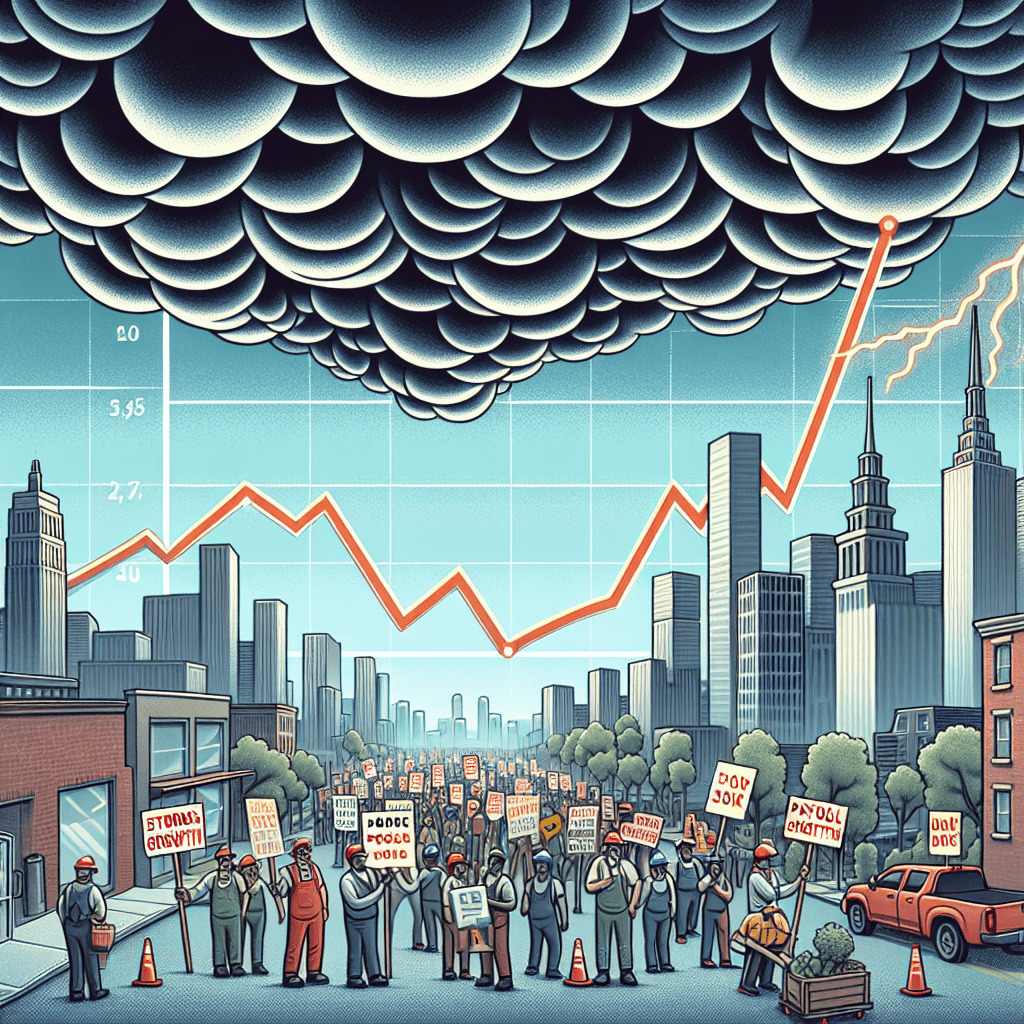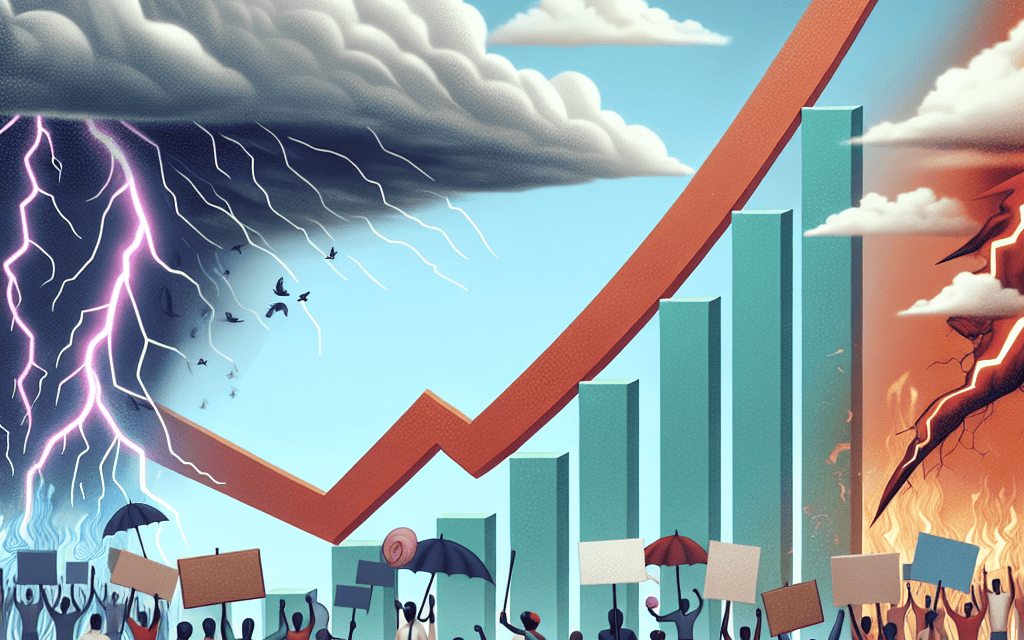“October Payrolls: Weathering Storms and Strikes, Economy Faces Turbulence”
Introduction
In October, the U.S. labor market experienced a notable slowdown in payroll growth, influenced significantly by adverse weather conditions and widespread labor strikes. The month saw a series of storms that disrupted economic activities across several regions, leading to temporary business closures and reduced hiring. Concurrently, major labor strikes, particularly in the automotive and healthcare sectors, further compounded the impact on employment figures. These factors collectively contributed to a more subdued job creation pace, highlighting the vulnerability of the labor market to both natural and industrial disruptions. As policymakers and economists analyze these developments, the focus remains on understanding the underlying resilience of the job market and anticipating potential rebounds in the coming months.
Analysis Of October Payrolls: The Role Of Storms And Strikes
In October, the U.S. labor market experienced a notable shift, influenced by a confluence of natural and industrial disruptions. The latest payroll data reveals a complex picture, where the impacts of severe weather events and widespread labor strikes have left an indelible mark on employment figures. As analysts delve into the numbers, it becomes evident that these factors have played a significant role in shaping the economic landscape for the month.
To begin with, the occurrence of severe storms across various regions of the United States has had a tangible effect on employment. Hurricanes and tropical storms, particularly those affecting the southeastern states, have led to temporary business closures and disruptions in daily operations. Consequently, sectors such as hospitality, retail, and construction have seen a decline in payroll numbers as businesses grapple with the immediate aftermath of these natural disasters. The temporary nature of these disruptions suggests that while the impact is significant, it may not have long-term implications for the labor market. However, the immediate effect is a reduction in job growth, as businesses focus on recovery and rebuilding efforts.
In addition to weather-related challenges, the labor market in October was also influenced by a series of high-profile strikes. Workers across various industries, including automotive, healthcare, and education, have engaged in strikes to demand better wages and working conditions. These labor actions have resulted in a temporary reduction in employment figures, as striking workers are not counted in the payroll data. The automotive industry, in particular, has been significantly affected, with major manufacturers experiencing production halts due to worker walkouts. This has not only impacted the companies directly involved but also had a ripple effect on the supply chain, affecting related industries and further contributing to the decline in payroll numbers.
Moreover, the combination of storms and strikes has created a unique set of challenges for policymakers and economists attempting to interpret the data. The dual impact of these events complicates the task of distinguishing between temporary disruptions and underlying trends in the labor market. While it is clear that both factors have contributed to the slowdown in payroll growth, it is essential to consider the broader economic context. The U.S. economy has been showing signs of resilience, with consumer spending and business investment remaining relatively robust. However, the interplay of these disruptive events with existing economic conditions necessitates a cautious approach in drawing conclusions about the overall health of the labor market.
Furthermore, as the nation moves forward, the focus will likely shift towards recovery and adaptation. Businesses affected by storms will need to rebuild and restaff, potentially leading to a rebound in employment figures in the coming months. Similarly, the resolution of labor disputes could result in a return to normalcy for affected industries, with workers resuming their roles and contributing to payroll growth. Nevertheless, these events serve as a reminder of the vulnerabilities inherent in the labor market and the need for strategies to mitigate the impact of such disruptions in the future.
In conclusion, the October payroll data underscores the significant influence of external factors such as storms and strikes on the U.S. labor market. While these events have temporarily dampened job growth, the underlying resilience of the economy suggests potential for recovery. As stakeholders analyze the data, it is crucial to consider both the immediate impacts and the broader economic context to gain a comprehensive understanding of the labor market dynamics at play.
Economic Implications Of Weather And Labor Disruptions On Payrolls
In October, the United States experienced a notable slowdown in payroll growth, a development largely attributed to the dual impact of severe weather events and widespread labor strikes. These factors have introduced a layer of complexity to the economic landscape, challenging analysts and policymakers as they attempt to interpret the underlying health of the labor market. The confluence of these disruptions has underscored the vulnerability of economic indicators to external shocks, prompting a closer examination of their implications.
To begin with, the impact of weather-related disruptions cannot be overstated. October witnessed a series of storms that swept across various regions, causing significant damage and displacing thousands of workers. These natural events led to temporary business closures, particularly in sectors such as construction, retail, and hospitality, which are highly sensitive to weather conditions. Consequently, the temporary halt in operations resulted in a reduction in hours worked and, in some cases, layoffs. This phenomenon highlights the intricate relationship between weather patterns and economic activity, as adverse conditions can swiftly translate into tangible economic consequences.
Simultaneously, the labor market faced additional pressure from a wave of strikes that affected key industries. Notably, the automotive and healthcare sectors were at the forefront of these labor actions, as workers demanded better wages and improved working conditions. The strikes led to significant disruptions in production and service delivery, further compounding the challenges faced by businesses already grappling with weather-related setbacks. The ripple effects of these strikes were felt across supply chains, exacerbating existing bottlenecks and contributing to a slowdown in economic momentum.
Moreover, the interplay between these disruptions and broader economic trends cannot be ignored. The Federal Reserve has been closely monitoring labor market dynamics as it navigates its monetary policy strategy. The October payroll data, skewed by these temporary factors, presents a conundrum for policymakers seeking to gauge the true state of employment. While the headline figures may suggest a deceleration in job creation, it is crucial to disentangle the transitory effects from underlying trends. This task is further complicated by the ongoing recovery from the pandemic, which continues to influence labor market behavior in unpredictable ways.
In light of these challenges, it is essential to consider the potential long-term implications of such disruptions. The increased frequency and intensity of weather events, likely exacerbated by climate change, pose a persistent threat to economic stability. As businesses and communities grapple with these challenges, there is a growing need for adaptive strategies that enhance resilience and mitigate the impact of future disruptions. Similarly, the labor strikes underscore the importance of addressing worker grievances to prevent prolonged industrial actions that can hinder economic progress.
In conclusion, the October payrolls report serves as a reminder of the multifaceted nature of economic indicators and the myriad factors that can influence them. The combined impact of storms and strikes has highlighted the need for a nuanced understanding of labor market dynamics, one that accounts for both temporary disruptions and structural shifts. As the United States continues to navigate these challenges, policymakers and businesses alike must remain vigilant, adapting to an ever-evolving economic landscape shaped by both natural and human forces.
How Natural Disasters And Labor Strikes Affect Employment Numbers
In October, the United States experienced a notable fluctuation in payroll growth, primarily influenced by natural disasters and labor strikes. These factors, while distinct in nature, collectively contributed to a complex employment landscape, underscoring the intricate interplay between environmental events and labor dynamics. Understanding the impact of these elements on employment numbers requires a closer examination of how they disrupt economic activities and influence labor market trends.
Natural disasters, such as hurricanes and severe storms, have a profound effect on employment figures. In October, several regions in the United States were hit by intense weather events, leading to temporary business closures and disruptions in various sectors. The immediate aftermath of such disasters often sees a decline in employment as businesses pause operations to assess damage and ensure safety. For instance, the hospitality and retail sectors, which rely heavily on consumer presence, are particularly vulnerable to such disruptions. Consequently, the temporary suspension of activities in these sectors can lead to a noticeable dip in payroll numbers.
Moreover, the impact of natural disasters extends beyond immediate job losses. The reconstruction and recovery phase, while eventually contributing to job creation, initially diverts resources and labor away from regular business operations. This shift can result in a temporary imbalance in employment figures, as the workforce is redirected towards recovery efforts. Additionally, the uncertainty and logistical challenges posed by natural disasters can delay hiring decisions, further affecting payroll growth in the short term.
In parallel, labor strikes have emerged as another significant factor influencing October’s employment numbers. Strikes, often driven by disputes over wages, working conditions, or benefits, can lead to substantial disruptions in production and services. In October, several high-profile strikes across various industries, including automotive and healthcare, highlighted the growing tensions between employers and employees. These strikes not only halted production lines but also led to temporary layoffs, thereby impacting payroll statistics.
The ripple effects of labor strikes extend beyond the immediate cessation of work. Strikes can strain supply chains, delay product deliveries, and create uncertainty in the market, all of which can influence employment decisions. Employers may hesitate to hire new workers or expand operations amidst ongoing labor disputes, contributing to a stagnation in payroll growth. Furthermore, the resolution of strikes often involves negotiations that can lead to changes in employment terms, potentially affecting future hiring and payroll trends.
While natural disasters and labor strikes individually pose challenges to employment numbers, their simultaneous occurrence in October amplified their impact. The convergence of these factors created a unique scenario where businesses had to navigate both environmental disruptions and labor unrest. This dual challenge required strategic adjustments in workforce management, as companies sought to balance immediate operational needs with long-term employment strategies.
In conclusion, the interplay between natural disasters and labor strikes significantly influenced the US payroll growth in October. These events, while distinct, collectively underscored the vulnerability of employment figures to external disruptions. As businesses and policymakers strive to mitigate the impact of such events, understanding their effects on employment dynamics becomes crucial. By analyzing these influences, stakeholders can develop more resilient strategies to navigate future challenges, ensuring a more stable and robust labor market.
The Intersection Of Climate Events And Labor Movements In October Payrolls

In October, the United States experienced a notable fluctuation in payroll growth, influenced significantly by a combination of climate events and labor movements. This intersection of natural and human factors has brought to light the intricate dynamics that can affect economic indicators such as employment figures. As the month unfolded, the nation witnessed a series of storms that disrupted various sectors, alongside widespread labor strikes that further compounded the challenges faced by employers and employees alike.
To begin with, the impact of climate events on payrolls cannot be understated. October saw several severe weather incidents, including hurricanes and storms, which led to temporary business closures and disruptions in operations. These natural occurrences primarily affected industries such as agriculture, construction, and transportation, where outdoor and logistical activities are heavily dependent on weather conditions. Consequently, many workers in these sectors faced reduced hours or temporary layoffs, contributing to a slowdown in payroll growth. The immediate aftermath of such storms often involves a period of recovery and rebuilding, which can delay the return to normal employment levels.
In parallel, the labor market in October was also significantly influenced by a wave of strikes across various industries. Notably, the automotive and healthcare sectors experienced substantial labor movements, as workers demanded better wages, improved working conditions, and more comprehensive benefits. These strikes, while highlighting critical issues within the labor force, also led to temporary work stoppages, affecting payroll numbers. The automotive industry, for instance, saw production halts that not only impacted the workers directly involved but also had ripple effects on supply chains and related businesses.
Moreover, the convergence of these climate and labor factors has underscored the complexity of accurately assessing payroll growth. Economists and policymakers are tasked with disentangling the effects of temporary disruptions from underlying economic trends. While storms and strikes are often transient, their immediate impact can skew monthly employment data, making it challenging to gauge the true health of the labor market. This necessitates a nuanced approach to interpreting such figures, taking into account both short-term anomalies and long-term patterns.
Furthermore, the October payroll scenario has sparked discussions on the resilience and adaptability of the workforce in the face of such challenges. Employers are increasingly recognizing the need for contingency plans and flexible work arrangements to mitigate the effects of unforeseen disruptions. Similarly, there is a growing emphasis on the importance of dialogue between employers and employees to address grievances and prevent prolonged labor disputes. These strategies are crucial in ensuring that the labor market remains robust and capable of withstanding both natural and man-made challenges.
In conclusion, the intersection of climate events and labor movements in October has provided valuable insights into the multifaceted nature of payroll growth. While storms and strikes have posed significant challenges, they have also highlighted areas for improvement in terms of workforce resilience and labor relations. As the nation moves forward, it is imperative to consider these factors in shaping policies that support sustainable employment growth. By doing so, the United States can better navigate the complexities of its labor market, ensuring stability and prosperity in the face of both predictable and unpredictable challenges.
Understanding The October Payrolls Dip: Storms And Strikes Explained
In October, the United States experienced a notable dip in payroll growth, a development that has sparked considerable discussion among economists and policymakers. This decline can be attributed to a confluence of factors, primarily the impact of severe weather events and widespread labor strikes. Understanding the nuances of these influences is crucial for comprehending the broader economic implications.
To begin with, the month of October was marked by a series of intense storms that swept across various regions of the country. These weather disturbances not only disrupted daily life but also had a significant impact on economic activities. Businesses, particularly those in the retail and service sectors, faced temporary closures, leading to a reduction in working hours and, consequently, payroll numbers. Moreover, the construction industry, which is highly sensitive to weather conditions, saw a slowdown in projects, further contributing to the decline in employment figures. The adverse weather conditions thus played a pivotal role in the reduced payroll growth observed during this period.
In addition to the weather-related disruptions, October was also characterized by a wave of labor strikes that affected several key industries. Notably, the automotive sector witnessed significant labor unrest, with workers demanding better wages and improved working conditions. These strikes led to temporary shutdowns of production lines, resulting in a substantial number of workers being off the payroll for the duration of the strikes. The ripple effects of these labor actions were felt across the supply chain, impacting not only the companies directly involved but also their suppliers and related businesses. Consequently, the strikes contributed to the overall decline in payroll numbers for the month.
Furthermore, the combination of storms and strikes created a challenging environment for businesses trying to maintain their workforce levels. Employers faced the dual challenge of managing operational disruptions while also addressing the demands of striking workers. This situation led to a cautious approach in hiring, as companies opted to delay new hires until there was more clarity on both the weather front and labor negotiations. As a result, the pace of job creation slowed, further exacerbating the dip in payroll growth.
Despite these challenges, it is important to note that the underlying fundamentals of the US economy remain robust. The labor market, although temporarily affected, continues to exhibit resilience. Many economists believe that the October dip in payrolls is a temporary setback rather than a sign of a broader economic downturn. As weather conditions stabilize and labor disputes are resolved, it is expected that payroll growth will regain momentum in the coming months.
In conclusion, the decline in US payroll growth in October can be largely attributed to the combined effects of severe weather events and widespread labor strikes. These factors created a temporary disruption in economic activities, leading to a slowdown in job creation. However, the resilience of the underlying economic fundamentals suggests that this dip is likely to be short-lived. As businesses recover from these disruptions and resume normal operations, payroll growth is expected to rebound, reflecting the continued strength of the US economy. Understanding these dynamics is essential for policymakers and stakeholders as they navigate the complexities of the current economic landscape.
The Ripple Effect Of Storms And Strikes On US Employment Statistics
In October, the United States experienced a notable fluctuation in payroll growth, primarily influenced by a combination of severe weather events and widespread labor strikes. These factors, while distinct in nature, collectively contributed to a complex employment landscape, underscoring the interconnectedness of environmental and socio-economic elements in shaping labor market dynamics.
To begin with, the impact of storms on employment cannot be understated. October witnessed several significant weather disturbances, including hurricanes and severe storms, which disrupted daily life and economic activities across various regions. These natural events led to temporary business closures, particularly in sectors such as retail, hospitality, and construction, where outdoor and customer-facing operations are prevalent. Consequently, many workers faced reduced hours or temporary layoffs, directly affecting payroll figures. The immediate aftermath of such storms often sees a decline in employment numbers as businesses assess damages and prioritize recovery efforts over regular operations.
Simultaneously, the month of October was marked by a series of labor strikes across key industries, further complicating the employment scenario. Notably, strikes in the automotive and healthcare sectors drew national attention, as workers demanded better wages, improved working conditions, and more comprehensive benefits. These strikes resulted in significant work stoppages, affecting thousands of employees and, by extension, the payroll statistics. The ripple effect of these strikes extended beyond the immediate industries involved, influencing supply chains and related sectors, thereby amplifying their impact on the overall employment figures.
Moreover, the convergence of these storms and strikes during the same period created a unique challenge for economists and policymakers attempting to interpret the employment data. While it is common for employment figures to fluctuate due to seasonal and cyclical factors, the simultaneous occurrence of these disruptive events added layers of complexity to the analysis. It became essential to distinguish between temporary disruptions and more systemic issues within the labor market to accurately assess the health of the economy.
In light of these challenges, it is crucial to consider the broader implications of such disruptions on the labor market. For instance, the temporary nature of storm-related job losses suggests a potential rebound in employment figures as recovery efforts progress and businesses resume normal operations. On the other hand, the outcomes of labor strikes could lead to more lasting changes in employment conditions, depending on the resolutions reached between workers and employers. These negotiations may result in improved labor contracts, which could enhance job satisfaction and stability in the long term.
Furthermore, the interplay between environmental events and labor actions highlights the need for adaptive strategies in workforce management and economic planning. Businesses and policymakers must develop robust contingency plans to mitigate the impact of unforeseen disruptions, ensuring resilience in the face of both natural and human-induced challenges. This includes investing in infrastructure that can withstand severe weather, as well as fostering open dialogue between employers and employees to address grievances before they escalate into strikes.
In conclusion, the October payrolls growth in the United States serves as a poignant reminder of the multifaceted nature of employment statistics. The combined effects of storms and strikes underscore the importance of a nuanced understanding of labor market dynamics, as well as the need for proactive measures to safeguard economic stability. As the nation moves forward, it is imperative to learn from these experiences and implement strategies that enhance the resilience and adaptability of the workforce in an ever-changing environment.
October Payrolls: A Closer Look At External Disruptions And Their Impact
In October, the U.S. labor market experienced notable fluctuations, primarily influenced by external disruptions such as severe weather events and widespread labor strikes. These factors played a significant role in shaping the payroll growth for the month, offering a complex picture of the economic landscape. As we delve into the details, it becomes evident that these disruptions have both immediate and potentially long-lasting effects on employment figures.
To begin with, the impact of severe weather, particularly hurricanes, cannot be understated. October saw several regions across the United States grappling with the aftermath of intense storms. These natural disasters led to temporary business closures, especially in sectors like retail, hospitality, and construction, which are highly sensitive to weather conditions. Consequently, the temporary suspension of operations in these industries resulted in a short-term dip in employment numbers. Workers in affected areas faced reduced hours or temporary layoffs, contributing to the overall slowdown in payroll growth. However, it is important to note that such weather-related disruptions are typically transient, with employment figures often rebounding in subsequent months as recovery and rebuilding efforts commence.
In addition to weather-related challenges, October was marked by significant labor strikes, which further complicated the employment landscape. High-profile strikes in key industries, such as automotive and healthcare, drew national attention and had a tangible impact on payroll figures. Workers participating in these strikes were temporarily removed from payrolls, leading to a noticeable decline in employment numbers for the month. The automotive industry, in particular, experienced substantial disruptions as workers demanded better wages and working conditions. These strikes not only affected the immediate payroll data but also highlighted underlying tensions within the labor market, raising questions about the future of labor relations in the U.S.
Moreover, the convergence of these external factors with existing economic conditions adds another layer of complexity. The U.S. economy has been navigating a period of uncertainty, characterized by fluctuating consumer demand and ongoing supply chain challenges. In this context, the disruptions caused by storms and strikes have exacerbated existing vulnerabilities, making it difficult to discern the true state of the labor market. While some sectors have shown resilience, others continue to struggle with the compounded effects of these disruptions.
Despite these challenges, there are reasons for cautious optimism. Historically, the U.S. labor market has demonstrated a remarkable ability to recover from temporary setbacks. As businesses reopen and workers return to their jobs, it is expected that payroll growth will regain momentum in the coming months. Additionally, the resolution of labor disputes and the implementation of recovery efforts in storm-affected areas are likely to contribute to a more stable employment environment.
In conclusion, the October payroll data underscores the significant impact of external disruptions on the U.S. labor market. While severe weather events and labor strikes have temporarily hindered payroll growth, these challenges are not insurmountable. By understanding the interplay between these factors and the broader economic context, policymakers and businesses can better navigate the path to recovery. As the nation moves forward, it will be crucial to address the underlying issues highlighted by these disruptions, ensuring a more resilient and equitable labor market for the future.
Q&A
1. **Question:** How did storms affect US October payrolls growth?
– **Answer:** Storms led to temporary business closures and disruptions, reducing the number of hours worked and impacting payrolls growth.
2. **Question:** What role did strikes play in influencing October payroll figures?
– **Answer:** Strikes, particularly in key industries like automotive, resulted in a significant number of workers being temporarily off payrolls, thereby reducing overall employment growth for the month.
3. **Question:** Which sectors were most affected by the storms and strikes in October?
– **Answer:** The manufacturing sector, especially automotive, was heavily impacted by strikes, while retail and hospitality sectors faced disruptions due to storms.
4. **Question:** Did the storms and strikes have a long-term impact on employment trends?
– **Answer:** The impact was primarily short-term, with expectations of a rebound in subsequent months as businesses resumed normal operations and striking workers returned.
5. **Question:** How did these events affect wage growth in October?
– **Answer:** Wage growth may have seen a temporary uptick as businesses offered higher wages to attract workers in unaffected areas or industries, but overall wage data could be skewed by the temporary reduction in lower-wage jobs.
6. **Question:** What was the overall change in payroll numbers for October?
– **Answer:** The overall change in payroll numbers showed a slowdown in growth compared to previous months, reflecting the combined impact of storms and strikes.
7. **Question:** How did these factors influence the Federal Reserve’s economic outlook?
– **Answer:** The Federal Reserve likely viewed the slowdown as temporary, focusing on underlying economic trends and considering these disruptions as short-term anomalies in their policy assessments.
Conclusion
The October payrolls growth in the United States was notably impacted by adverse weather conditions and labor strikes. Severe storms disrupted economic activities, particularly in sectors reliant on outdoor work, such as construction and agriculture, leading to temporary job losses or reduced hiring. Concurrently, widespread labor strikes, especially in key industries like automotive and healthcare, further constrained employment growth as workers protested for better wages and conditions. These factors combined to create a temporary slowdown in job creation, highlighting the vulnerability of the labor market to both natural and socio-economic disruptions. However, as these events are typically short-lived, the underlying strength of the labor market is expected to rebound in subsequent months, assuming no further significant disruptions.





